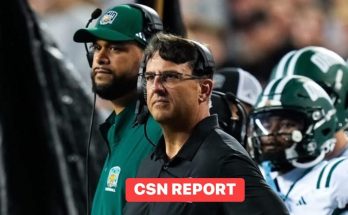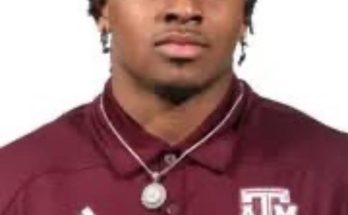In a landscape increasingly dominated by eye-popping NIL (Name, Image, and Likeness) deals, where college athletes can earn millions before even stepping onto a professional field, decisions surrounding commitments and transfers are often driven by financial incentives. Yet, in an unprecedented move that has sent ripples through college football and NIL circles, Cade Klubnik, one of the nation’s most coveted quarterback prospects, has chosen to reject a staggering $6.5 million NIL offer from the University of Southern California (USC) — an offer that, by all accounts, would have been life-changing for most athletes. Instead, Klubnik opted to stay true to his initial commitment, placing loyalty, trust, and long-term growth above immediate financial gain.
Cade Klubnik’s decision goes beyond a simple choice about where to play football; it strikes at the heart of what college athletics, particularly football, is becoming in the NIL era. His refusal to chase the largest NIL offer available highlights the evolving values of the new generation of athletes who seek to balance their careers, personal development, and ethical considerations in a complex, rapidly shifting environment.
Klubnik, a highly-touted quarterback recruit ranked among the top prospects nationally, has been a subject of intense recruitment battles since high school. His talent on the field is matched only by his character off it, and his decision to stay committed to his original program, despite the lure of a $6.5 million endorsement package, has elevated him from a promising player to a symbol of loyalty and integrity in college sports.
The USC NIL offer was reportedly structured with a combination of direct payments, endorsement contracts, and sponsorship deals spanning apparel, technology, lifestyle brands, and local business ventures. To contextualize the size of this deal, the average NIL contracts for top-tier quarterbacks often fall significantly below this threshold. The sheer size and scope of the offer underscored how aggressively programs and their affiliates are willing to pursue top talent in the post-NIL era. Yet Klubnik’s rejection reflects a conscious pushback against the commodification of college athletes and a nuanced understanding of what matters most to him beyond immediate financial gain.
Loyalty is a concept frequently discussed but seldom embodied so visibly in the current sports environment, where transfers, decommitments, and professional ambitions frequently disrupt traditional pathways. Klubnik’s decision serves as a reminder that for some athletes, their commitment to a program is not just a stepping stone but a deeply rooted belief in the vision, culture, and people they initially trusted.
The college that Klubnik stayed loyal to has also played a significant role in shaping his choice. The coaching staff, the relationships with teammates, and the developmental approach promised a pathway not just for football success but also for personal growth and leadership development. Klubnik reportedly felt that these intangibles — things that money cannot buy — outweighed the immediate perks USC dangled before him.
Beyond the individual implications for Klubnik, his decision opens a broader dialogue about the nature of NIL deals and the future of college sports recruiting. NIL has undoubtedly transformed the recruiting landscape, creating a competitive market where schools are willing to leverage enormous sums to secure elite athletes. However, Klubnik’s choice highlights that while money is powerful, it is not always the ultimate deciding factor for every athlete. Values, trust, culture, and vision remain compelling reasons for choosing a program.
This decision also puts a spotlight on the ethical and practical questions surrounding NIL. Critics argue that NIL deals, particularly those that are lavish and unsolicited, risk turning college sports into a bidding war where financial muscle overshadows athletic and academic priorities. Klubnik’s rejection signals that despite the hype, there is space for athletes who want to maintain a degree of control over their narrative and make choices aligned with their personal principles.
Moreover, Klubnik’s stance could inspire other athletes to reconsider what success means in the NIL era. While many athletes are justified in capitalizing on their marketability to secure their futures, Klubnik’s example shows that long-term personal development, loyalty to a program, and the opportunity to grow in a supportive environment can be just as valuable, if not more so, than the immediate cash payout.
The decision also reinforces the role of the collegiate experience as a holistic journey. For many athletes, college is not just a stepping stone to professional leagues but a critical period for academic, social, and personal development. Choosing a program that offers stability, mentorship, and a genuine investment in the athlete’s future can be a game-changer beyond sports. Klubnik’s rejection of the USC deal underscores that the allure of multimillion-dollar NIL contracts does not always eclipse these considerations.
Furthermore, Klubnik’s decision carries significant recruiting implications. Programs may need to reconsider their approach to NIL offers, recognizing that while big-money deals can attract attention, they do not guarantee commitment or satisfaction. Building genuine relationships, fostering a positive team culture, and presenting a clear vision for an athlete’s development might ultimately be more effective than merely outbidding competitors financially.
It is also important to consider the pressures athletes face in today’s environment. With NIL offers often linked to brand-building and public image management, young athletes can find themselves navigating complex business negotiations alongside their athletic and academic responsibilities. Klubnik’s choice to reject a lucrative deal can be interpreted as a deliberate effort to maintain focus on his development as a player and individual without being distracted or overwhelmed by external pressures.
In many ways, Cade Klubnik’s decision could be viewed as a pioneering moment in college athletics, a case study of balancing financial opportunity with personal integrity. It challenges the narrative that athletes must always choose the biggest paycheck and suggests a future where athletes, programs, and NIL partners collaborate in ways that respect the holistic needs of the player.
Of course, the financial realities for many athletes remain a pressing concern. NIL deals provide crucial opportunities to athletes who might come from economically disadvantaged backgrounds or face significant financial challenges. Cade Klubnik’s position of privilege — as a top prospect with a solid support system — may afford him the luxury to prioritize loyalty and long-term vision over immediate NIL income. However, his decision does not diminish the importance of NIL for the broader athlete community; instead, it highlights the diversity of athlete experiences and priorities in this new era.
From a program perspective, the loyalty shown by Klubnik offers a rare and valuable asset. Coaches and administrators recognize that recruiting elite talent is not just about winning the bidding war but about fostering a supportive environment where athletes feel valued beyond their marketability. Klubnik’s commitment sends a powerful message to the team and fan base, illustrating that trust and mutual respect can still thrive amid the commercial pressures of modern college sports.
Moreover, Klubnik’s rejection of the USC offer might encourage programs to think creatively about NIL partnerships — focusing not just on money but on building lasting relationships with brands that align with an athlete’s values and identity. This approach could create more sustainable, authentic endorsement deals that benefit both the athlete and the community around them.
For fans and observers of college football, this moment is refreshing. In an era where headlines often focus on transfers, NIL battles, and mercenary motives, Cade Klubnik’s choice reminds everyone why the sport still resonates deeply: it’s about dedication, passion, and the pursuit of excellence within a team environment. His loyalty adds a narrative layer that transcends statistics and highlight reels, inviting fans to appreciate the human side of college athletics.
Looking ahead, the ramifications of Klubnik’s decision may unfold over several years. How he performs on the field, how he navigates his NIL opportunities within the program he chose, and how other athletes and programs respond will all be critical to watch. His choice may inspire a new generation of athletes who view NIL not just as a payday but as one component of a broader, more meaningful athletic and personal journey.
Ultimately, Cade Klubnik’s rejection of a $6.5 million NIL offer from USC is a landmark moment in college sports. It challenges assumptions about what motivates athletes and offers a hopeful glimpse into a future where loyalty, culture, and personal values can coexist with financial opportunity. In doing so, Klubnik has not only preserved his integrity but has set a powerful example for athletes, programs, and fans alike — proving that sometimes the most significant victories happen off the field.



